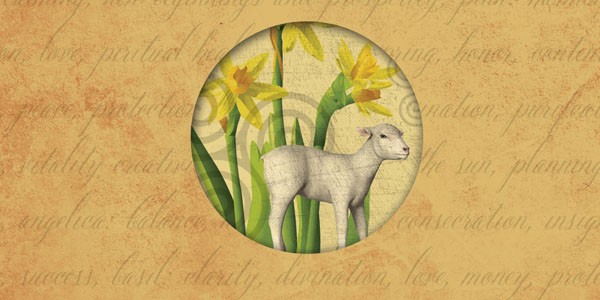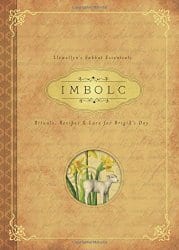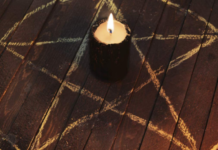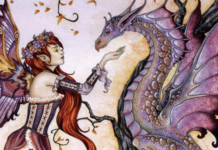
 Imbolc: Rituals, Recipes & Lore for Brigid’s Day, by Carl F. Neal
Imbolc: Rituals, Recipes & Lore for Brigid’s Day, by Carl F. Neal
Llewellyn Worldwide, 978-0-7387-4541-1, 204 pp. (incl. correspondences, further reading, bibliography, endnotes, and index), 2015
Another title in Llewellyn’s Sabbat Essentials series, Imbolc: Rituals, Recipes & Lore for Brigid’s Day, by Carl F. Neal, explores the serene significance and suggested celebrations of this oft-overlooked sabbat. Following the structure of the other books in the series, Imbolc delves into both the old and new ways of celebrating and customs, the history of Imbolc, and other global celebrations held around the same time as the sabbat, spells, divination, recipes, crafts, prayers, invocations, rituals and celebrations, as well as correspondences and further reading.
A quick confession: I’m one of those people who is consistently unprepared for Imbolc, one who only realizes it’s Imbolc the day of, or even the day after. Whether Brigid whispered in my ear at the beginning of the year or by some other serendipity, preparation for Imbolc began in a whirlwind of organizing, donating, and cleaning in a fury, both in my house and in my life. Not understanding where this drive came from, within reading the first two pages of Imbolc, the torch of realization flared. “This is the year.” Sprouting from these actions, a warmth and sense of peace and purpose have wrapped me in the gentle glow of Imbolc.
Neal states, “Imbolc is a time when new plans are made and new ideas are ‘planted.’ It is also traditionally a time to examine the people, objects, and philosophies in our lives. It is an opportunity to discard the things we don’t need or that are holding us back.”1 He refers to it as a “winter cocoon,” and as we emerge, we may be “greatly changed” from who we were at Yule.
The impulse to rid myself of physical, mental, emotional, and spiritual clutter was overwhelming in the four weeks leading up to Imbolc. Clearly, Brigid has decided to make her presence prominent in my life for this year, and the first few pages of Imbolc confirmed this.
The first point Neal makes clear is that Imbolc is celebrated on February 1 — not February 2, as many people believe. While Candlemas (a Christian holiday) and Imbolc are often conflated in popular culture as the one holiday, they are, in fact, not the same.2 Indeed, the Christian Candlemas borrows heavily from Imbolc, especially in terms of the focus on fire and light, as when priests bless beeswax candles to use throughout the year.
Within the first chapter, Imbolc impresses upon the reader the significance of winter and the importance of fire to our ancestors.3 To our ancestors, winter was a time of hardship for which rigorous preparation was needed. Further, since they didn’t have our modern conveniences of refrigeration (for food preservation) or heat (for warmth), winter was a time of real life and death.
Our ancestors were in synch with nature, watching for and working with weather signs, wild animals as well as their livestock. Livestock was key to old world survival, and our ancestors’ lives depended on their livestock. Keeping their livestock alive during the winter meant survival through winter and into spring. If livestock died, there would be no fresh milk or meat, leading to starvation. In Imbolc, the author takes the reader through and impresses upon us the importance of this agricultural aspect.
Along with livestock, the significance of fire is explored as an element of reverence and respect, and the goddess with whom fire is associated: Brigid.4 As the goddess of the day, Brigid displays and manifests many aspects. She’s the goddess of “fire, flame, change, poetry and inspiration, transformation, wisdom, metalworking and the forge fire, healing, creativity, water, prophecy, education, learning, and she’s also credited with gifting the written word to humanity”,5 and is especially significant to writers and poets. Brigid also appears as maiden, mother, and crone.
For many, Imbolc is the celebration of Brigid, and rightly so. The author illustrates Brigid’s relevance in the modern world to 21st century women and to this sabbat.6 As a strong and wise goddess, Brigid exemplifies and embodies strength as well as serenity to women and to men, embodying the quiet power of this sabbat.
Brigid is called by many names: Goddess of the Eternal Flame, Goddess of the Sacred Well; there is Brigid of the Smiths, Brigid of the Healers, and Brigid of the Poets. Neal explores Brigid the goddess as well as her Christian transformation into Saint Brigid.7 As Saint Brigid, Neal touches upon the rich Irish and Celtic mythos of Brigid. Both as the goddess and as the saint, Brigid is the flame of transformation, burning away the old to prepare for the new.
Roman traditions (Februalia and Lupercalia), Native American, and Egyptian old ways are also touched upon, as are other celebrations held around the same time as Imbolc: Groundhog Day, Valentine’s Day, Mardi Gras, and Chinese New Year.
The old ways are the foundation upon which our new celebrations are based. As Neal states, “Imbolc is a very introspective and reflective time. It is a time for self-contemplation and planning. […] It is a time to discard the things that aren’t working and plan for new alternatives. Imbolc’s very personal nature makes this a more subtle sabbat than some.”8
So how does one celebrate in modern times? One way is to identify with the concepts of Imbolc and recognize the symbols. Says Neal, “those signs in the physical world are merely reflections of greater truths.” Rebirth, transformation, new beginnings, and ridding yourself of what’s not needed anymore in your life — those are the concepts. What are the signs? A great example is tiny blades of grass or plants pushing up through the dirt. But, what if there’s still snow on the ground? Notice how the daylight hours grow longer.
What actions can be undertaken in preparation for Imbolc? Focus on cleaning.9 Accumulation of all sorts of clutter happens in a blink: physical, mental, emotional, and magical. During the act and process of cleaning, negativity is cleared and energy moves, making space for the new and the positive. Sweeping, of course, is a traditional way to clean, and is as practical as it is magical.10 I can attest that the act of cleaning and sweeping is powerful, almost addictive.
Imbolc is also the time for all sorts of candle magick and divination. In the workings the author offers: the Brigid Candle Divination, Empowerment of the Milk Moon, Blessing of the Candles, and Goddess in the Air Divination, a beautiful sense of peace is offered up. Of these, the Milk Moon working is of particular interest. Says the author, it’s designed for people who are ready to help at a moment’s notice — putting others first before themselves, sometimes to the detriment of their own self. “This spell is intended to help with the problem by giving permission to the caster — for you — to look within and start healing the wounds of your inner self.” It’s a spell for self-empowerment. This is a working that speaks to me, and I’ll be trying this out on Imbolc Eve.
Milk and milk products are the focus of the recipes in Imbolc. Yogurt “cheese” is an easy, mouth-watering recipe (yes, add the suggested blackberry preserves), the butter recipe is straightforward (yum!), and the recipe for soda bread is perhaps the easiest of all. Sure, soda bread appears in markets closer to another holiday, but why wait? Celebrate Brigid and Imbolc in fine Irish Celtic fashion with this.11
On the crafts side, instructions for constructing Brigid’s Cross are provided (you’ll need a lot of preparation), as well as Imbolc incense, corn dollies, and dipped candle making. If you can’t make a Brigid’s Cross from traditional straw, modern materials can be used: pipe cleaners, drinking straws, and colored paper.12 Pipe cleaners are easy, colorful, and not a lot of preparation is necessary.
At the heart of the holiday is the promise of the new and healing. Blessings and prayers for new projects and new possibilities are offered, and the prayers for healing invoke Brigid to heal both mind and body.13 The suggested prayers are simple and beautiful.
In the chapter on rituals, there are rituals of celebration, rituals for solitary practice, couples, and groups. The most compelling one is the solitary Fire Seed ritual. This isn’t to be undertaken lightly and, to invoke an old cliché: be careful what you wish for. Neal writes, “Don’t create a fire seed without thinking about all the possible effects.” He also states that, “Fire seeds are more about what you need — but likely don’t want.”
Imbolc: Rituals, Recipe & Lore for Brigid’s Day is a small book packed with information for Imbolc and beyond. It will help plant the seed of change for practitioners at all levels. For me, it created a sense of new connection to Imbolc, and to Brigid in particular. A single candle in the darkness lights the way for oneself and others — the flame of Brigid lighting your soul fire for the rest of the year.
- p. 16 [↩]
- p. 15 [↩]
- p. 16-22 [↩]
- p. 22, 24-30 [↩]
- p. 24 [↩]
- p. 44-47 [↩]
- p. 26-30 [↩]
- p. 40 [↩]
- p. 53 [↩]
- p. 53, 54 [↩]
- p. 92-96 [↩]
- p. 104 [↩]
- p. 125-127 [↩]








